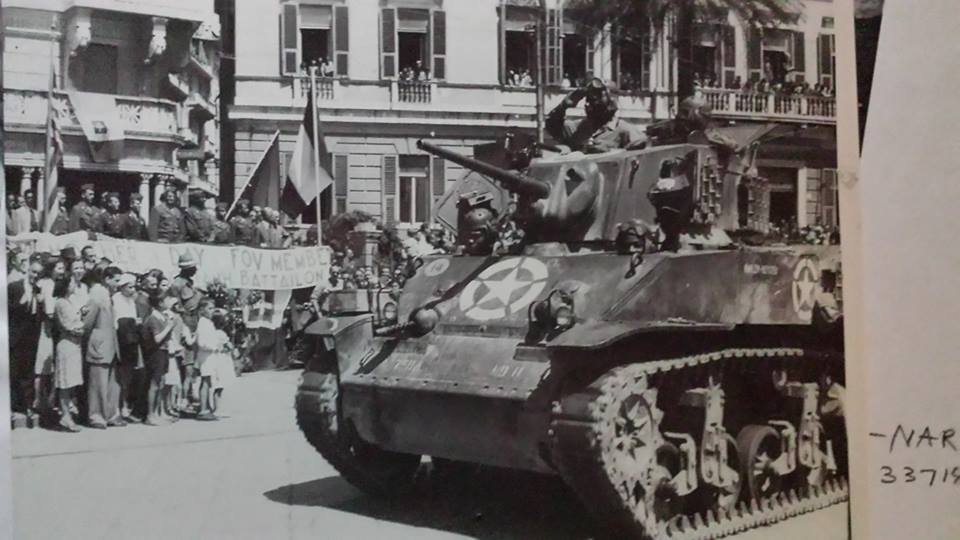| Black Panthers:
The First Black Tank Battalion Part 2
By Mike Bennighof, Ph.D.
April 2025
 The 758th Tank Battalion’s first opportunity to experience combat came on the day after Christmas 1944. The African-American battalion, equipped with M5 Stuart light tanks, had been attached to the segregated 92nd Infantry Division operating in northern Italy. The 758th Tank Battalion’s first opportunity to experience combat came on the day after Christmas 1944. The African-American battalion, equipped with M5 Stuart light tanks, had been attached to the segregated 92nd Infantry Division operating in northern Italy.
The 92nd Infantry Division’s Edward “Sic ’em Ned” Almond, easily the least competent and most deeply racist American division commander in Europe, had two tank battalions attached to his division rather than the usual one, and placed them well behind his lines in reserve. When the Germans and their Italian Fascist allies attacked, the tanks had no hope of reaching the beleaguered front-line battalions along the narrow mountain roads before they had been overrun. The light tanks of the 758th saw no action and suffered no losses.
The 92nd Infantry Division suffered a humiliating defeat; Indian and South African troops had to shore up their positions. The U.S. Army’s leadership blamed what they termed inherent racial defects of the troops rather than the blithering incompetence of Edward Almond. Almond maintained command of the division, which now began to gingerly probe the Axis positions along the Gothic Line. The light tanks participated in some of these patrols, losing two tanks to mechanical failure and four men wounded.
In early February the division began an offensive. The Buffalo Soldiers held the far left flank of Fifth Army, from the coast of the Ligurian Sea up into the mountains behind the beaches. Almond scattered the platoons of both of his attached tank battalions - the 758th with its light tanks and the Shermans of the white 760th Tank Battalion - among his infantry battalions. That wasn’t unusual; many division commanders followed a similar pattern, and usually with the same result. The tanks could not use their concentrated firepower and sheer bulk to force a breakthrough, though in the rugged terrain of the Apennine foothills its questionable whether they would have done better if concentrated.
The attack ended in disaster. The 92nd Infantry Division had received 2,600 replacements in January, men combed out of service units and lacking infantry basic training. Almond flung them into front-line battalions anyway, where they died in droves. The division suffered over 1,200 casualties, with Almond ignoring a direct order from his corps commander to break off the attack yet somehow keeping his job. The 758th Tank Battalion lost eight tanks, five to enemy fire and three bogged down and irrecoverable. Four men were wounded, but none killed.

The 758th Tank Battalion parades through Volterra, Italy. Mother’s Day 1945.
Almond once again blamed the failure on his troops, and convinced his patron, Army chief of staff George C. Marshall, to re-organize his division. Only the 370th Infantry Regiment would remain, exchanging about 1,200 men with the division’s other three regiments (unlike every other American infantry division, the 92nd had four rather than three regiments). The other regiments would be re-assigned to rear-area duties, replaced with the Japanese-American 442nd Infantry Regiment and the brand-new white 473rd Infantry Regiment, thrown together from four disbanded anti-aircraft battalions. Neither of the new regiments wore the Buffalo Soldier shoulder patch.
The 758th Tank Battalion remained attached to the division, as did the white 760th Tank Battalion. Two of the 758th’s three companies were attached to the new 473rd Infantry, with the remaining company plus the assault gun and mortar platoons held back as division-level reserves. They moved out with the infantry on 5 April 1945 as part of Operation Second Wind, a general offensive by Fifth Army in northern Italy.
This time the light tanks were in the thick of the action, mostly fighting alongside the former anti-aircraft gunners of the 473rd Infantry but also supporting the Nisei in the rugged mountain terrain. Now the African-American tankers saw heavy combat and began to take heavier losses; limited to the narrow mountain roads, they could not often accompany the infantry moving across country, and were vulnerable to German panzerfaust-equipped anti-tank teams.
The 758th Tank Battalion ended the offensive, and the war, gathered in the town of Voltri. This was the first time all three of its companies had been brought together since their arrival in Italy. During the April fighting the battalion lost nine tanks, one of those to mechanical failure, and four men killed in action.
Elated at his division’s success in the war’s last days, but crushed by the death of his son Edward Junior in France in March 1945, Almond continued to heap scorn on his African-American troops, advising the Army to never deploy them in combat again. After the war, Almond was shunted into a dead-end job managing personnel for the occupying forces in Japan, but caught the eye of Douglas MacArthur and became his chief of staff and, with MacArthur’s patronage, commander of X Corps in Korea. His failures in that post led to the disastrous retreat in the face of the Chinese winter offensive of 1951.
While Almond had failed upward, the 758th Tank Battalion would spend a few months on occupation duty in northern Italy. In September 1945 they turned in their tanks and the battalion was disbanded rather than heading home as a unit like most other formations. The men were dispersed among other African-American formations, mostly service units, and returned over the following weeks. There would be no homecoming parade for the 758th Tank Battalion, other than a final review in Genoa.
Given the harsh terrain over which they operated and their hapless division commander (assisted by a notably racist staff), it’s hard to assess the effectiveness of the first African-American tank battalion. It never had a chance to rack up the impressive record of its sister unit, the 761st “Black Panthers,” but it performed no worse than the white 760th Tank Battalion also attached to the 92nd Infantry Division.
That would not be the end for the 758th Tank Battalion. In 1946 - still segregated - it was re-activated as a heavy tank battalion at Fort Knox. Initially equipped with M4 Shermans, it later received the M26 Pershing and then the M46 Patton. In November 1949 it became the 64th Heavy Tank Battalion. In July 1950 the battalion was ordered to move to Korea to fight against the North Korean invaders, there to be re-united with Ned Almond. It began receiving white soldiers in May 1951 and by July 1953 when it was withdrawn from the front it had become fully integrated. But that’s another war and another story.
The full series is here:
• Race in America: Founded on Slavery
• Race in America: Civil War
• Race in America: Jim Crow
• Race in America: The Black Doughboys, Part One
• Race in America: The Black Doughboys, Part Two
• Race in America: Red Summer
• Race in America: Tulsa
• Race in America: Klan Scam
• Race in America: Strange Fruit
You can order the Black Panthers Historical Study right here.
That’s both history and scenarios.
Please allow an extra six weeks for delivery.
You can order the Separate, But Heroes book right here.
That’s just the exciting history.
Please allow an extra six weeks for delivery.
Sign up for our newsletter right here. Your info will never be sold or transferred; we'll just use it to update you on new games and new offers.
Mike Bennighof is president of Avalanche Press and holds a doctorate in history from Emory University. A Fulbright Scholar and NASA Journalist in Space finalist, he has published an unknowable number of books, games and articles on historical subjects.
He lives in Birmingham, Alabama with his wife and three children. He misses his dog, Leopold.
Daily Content includes no AI-generated content or third-party ads. We work hard to keep it that way, and that’s a lot of work. You can help us keep things that way with your gift through this link right here. |
